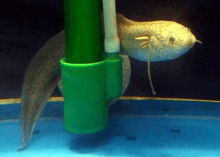Gilled lungfish
The gilled lungfish (Protopterus amphibius), also known as the East African lungfish, is a species of African lungfish.[1][5] It is found in the swamps and flood plains of East Africa, and has been positively identified in Kenya, Somalia and Mozambique.[1][5] Records from Tanzania require confirmation[5] and may be the result of introductions.[1]
| Gilled lungfish | |
|---|---|
 | |
| Scientific classification | |
| Kingdom: | Animalia |
| Phylum: | Chordata |
| Order: | Lepidosireniformes |
| Family: | Protopteridae |
| Genus: | Protopterus |
| Species: | P. amphibius |
| Binomial name | |
| Protopterus amphibius | |
| Synonyms[3][4] | |
| |
Description
Protopterus amphibius generally only reaches a length of 44 cm (17 in), making it the smallest extant lungfish.[5][6] This lungfish is uniform blue or slate grey in colour. It has small or inconspicuous black spots and a pale grey belly.[5] Like all African lungfish it has two lungs and is an obligate air-breather.[6] Also, like all other African lungfish, it is able to burrow and form a mucous cocoon for protection in a process known as estivation.[6]
Habitat
The gilled lungfish is a primarily demersal fish, living largely within the riverbeds of the Zambezi River system of East Africa.[7] It also inhabits similar areas in the wetlands of the region.[8]
Conservation
The gilled lungfish is listed as Least Concern, partially because reported numbers are high and partially because of the lack of data.[8] It is eaten for food by some natives of the area however the numbers lost to this practice are very small.[7] More dangerous threats are the damming of the Zambezi, which will reduce the size of the delta in which the fish live, and pollution in areas that the fish inhabit[8] as well as encroachment of wetlands for agriculture that reduces the available habitat.[8]
References
- Bills, R.; Engelbrecht, J.; Getahun, A. & Vreven, E. (2010). "Protopterus amphibius". IUCN Red List of Threatened Species. 2010: e.T182130A7811584. doi:10.2305/IUCN.UK.2010-3.RLTS.T182130A7811584.en. P. amphibius has been assessed as Least Concern because it has a very large range, and there are no known widespread threats to the species.
- ITIS.gov (Retrieved Feb. 19, 2010.)
- Haaramo, Mikko (2007). "Ceratodiformes – recent lungfishes". Mikko's Phylogeny Archive. Retrieved 3 July 2016.
- Froese, R.; Pauly, D. (2017). "Protopteridae". FishBase version (02/2017). Retrieved 18 May 2017.
- Froese, Rainer and Pauly, Daniel, eds. (2014). "Protopterus amphibius" in FishBase. April 2014 version.
- Primitive Fishes.com Archived 2008-12-11 at the Wayback Machine (Retrieved Feb. 19, 2010.)
- "Kenyan Lungfish (Protopterus amphibius) - Information on Kenyan Lungfish - Encyclopedia of Life". Encyclopedia of Life. Retrieved 2015-06-03.
- "Protopterus amphibius (East-coast Lungfish)". IUCN Red List of Threatened Species. Retrieved 2015-06-03.
- LungFish.info
- Gosse, J.-P. 1984 Protopteridae. p. 8-17. In J. Daget, J.-P. Gosse and D.F.E. Thys van den Audenaerde (eds.) Check-list of the freshwater fishes of Africa (CLOFFA). Volume I. ORSTOM, Paris and MRAC, Tervuren. 410 p. (Ref. 3498)
- Nelson, J. S. 2006. Fishes of the World, 4th edition. Hoboken, NJ: John Wiley & Sons. ISBN 0-471-25031-7.
- Rosen, D. E., P. I. Forey, B. G. Gardiner, and C. Patterson. 1981. Lungfishes, tetrapods, paleontology, and plesiomorphy. Bull. Am. Mus. Nat. Hist. 167(4): 159-276.
- Schultze, H. P., and J. Chorn. 1997. The Permo-Carboniferous genus Sagenodus and the beginning of modern lungfish. Contributions to Zoology 61(7): 9-70.
